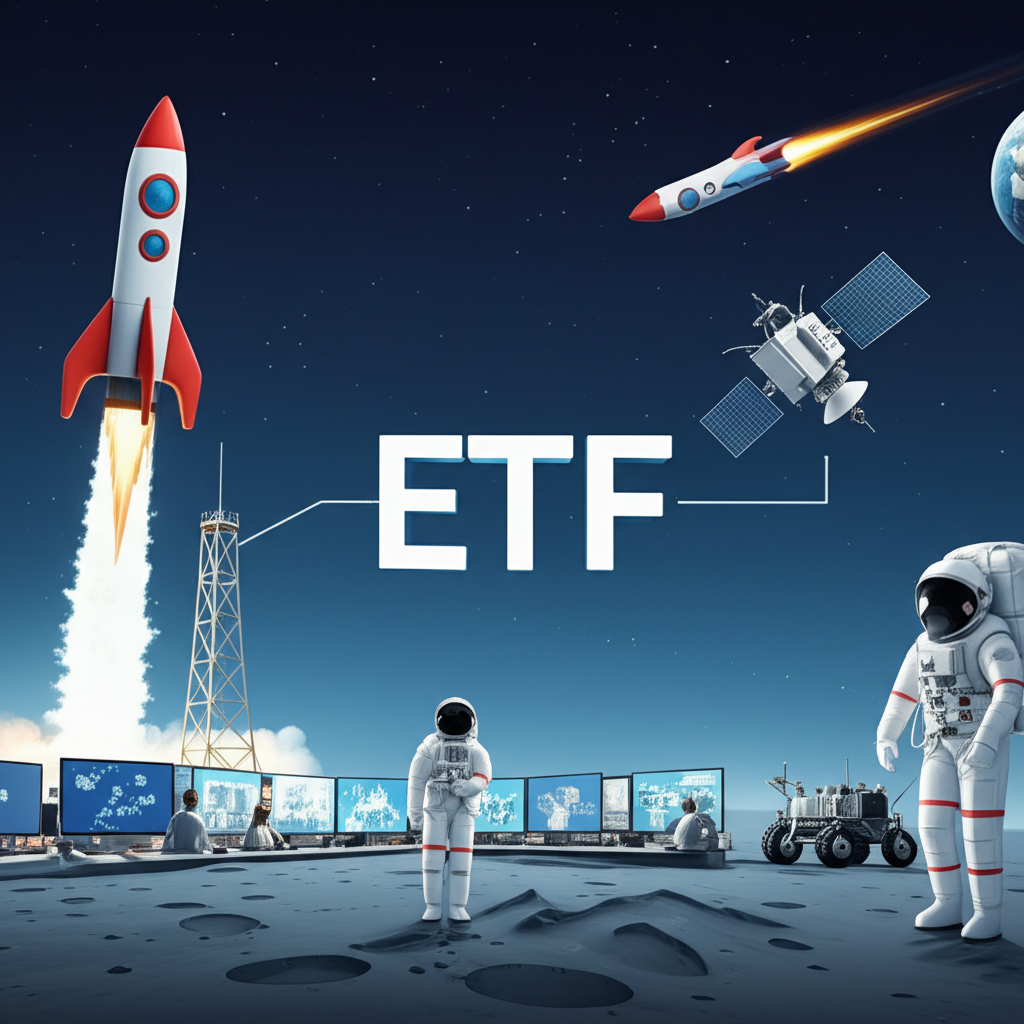Introduction: Charting Your Course in the Space Investment Frontier

The final frontier is no longer confined to the realm of science fiction or government-led exploration. Today, space has emerged as one of the most dynamic and rapidly expanding commercial sectors, driven by private innovation, technological leaps, and a growing appetite for connectivity and exploration. From reusable launch vehicles that slash mission costs to vast satellite constellations delivering high-speed internet across remote regions, the infrastructure of a new space economy is being built—right now. For investors, this shift opens a rare window of opportunity: the chance to back transformative technologies shaping the future of communication, transportation, and even human presence beyond Earth. Yet navigating this complex ecosystem can be daunting. Enter Space Exchange Traded Funds (ETFs)—a strategic, diversified gateway that allows investors to participate in the sector’s rise without having to pick individual winners. This guide unpacks the evolving landscape of space investing, highlights leading ETFs, and equips you with the insights needed to make informed decisions in this high-potential arena.
What Exactly Are Space ETFs?

Space ETFs are specialized investment vehicles that aggregate capital to invest in a curated basket of companies operating across the space value chain. Unlike general technology or industrial funds, these ETFs zero in on businesses directly contributing to the development and commercialization of space-based services and infrastructure. Their portfolios typically span multiple layers of the industry, from the rockets that breach the atmosphere to the data streams that power global decision-making.
Core areas of exposure include:
– **Launch Services:** Firms pioneering affordable access to orbit through reusable rockets and frequent launch capabilities, essential for deploying satellites and supporting human spaceflight.
– **Satellite Technology:** Companies designing, manufacturing, and operating satellites used for broadband internet, Earth imaging, GPS enhancement, and scientific research.
– **Space Exploration & Innovation:** Ventures focused on next-generation missions to the Moon, Mars, and beyond, including those exploring in-space manufacturing, asteroid mining, and sustainable orbital habitats.
– **Ground Infrastructure & Enabling Systems:** Providers of critical support systems such as ground stations, telemetry networks, data analytics platforms, and cybersecurity solutions tailored for space operations.
By bundling these diverse yet interconnected businesses, Space ETFs offer investors broad exposure to the sector’s growth trajectory. This structure not only mitigates the risk of relying on any single company but also captures the compounding momentum generated by cross-industry advancements in AI, robotics, and materials science.
Why Invest in the Space Economy Now? Growth Drivers and Market Potential

The case for investing in space has never been stronger. Once dominated by national space agencies, the sector is now fueled by private capital, entrepreneurial drive, and breakthrough technologies that are making space more accessible than ever before. The result? A thriving ecosystem where commercial activity now accounts for the vast majority of the global space economy.
Several powerful forces are accelerating this transformation:
– **Falling Launch Costs:** The advent of reusable rocket systems—pioneered by companies like SpaceX—has dramatically reduced the price of reaching orbit. This cost reduction is enabling more frequent missions and making space ventures financially viable for a broader range of players.
– **Private Sector Leadership:** New entrants such as Rocket Lab, Relativity Space, and Astra are bringing agility and innovation to launch services, while established aerospace firms are adapting to stay competitive. This shift has created a vibrant marketplace for space access.
– **Soaring Demand for Satellite Data:** Industries ranging from agriculture and logistics to insurance and national security rely on real-time Earth observation and global connectivity. Satellite internet providers like Starlink and OneWeb are deploying tens of thousands of low-Earth orbit (LEO) satellites to meet demand for high-speed broadband in underserved areas.
– **Government Support and Strategic Priorities:** National space programs continue to play a crucial role, with increased funding for lunar exploration (e.g., NASA’s Artemis program), national defense, and climate monitoring. Public-private partnerships are becoming the norm, de-risking innovation for private firms.
– **Emerging Frontiers:** While still in early stages, sectors like space tourism, in-orbit servicing, and resource extraction are moving from concept to reality. Virgin Galactic and Blue Origin have already flown commercial passengers, and lunar prospecting missions are on the horizon.
The numbers reflect this momentum. According to the Space Foundation, the global space economy reached $546 billion in 2022, marking an 8% year-over-year increase, with commercial activities contributing nearly 80% of total revenue. Space Foundation – The Space Report Looking ahead, analysts at Morgan Stanley project the industry could generate over $1 trillion in annual revenue by 2040, signaling a decade of exponential growth. Morgan Stanley – Space: Investing in the Final Frontier
*(Image: Infographic showing projected growth of the global space economy with key market segments)*
Space ETFs vs. Aerospace & Defense ETFs: A Critical Distinction

A common point of confusion for investors is the difference between Space ETFs and Aerospace & Defense (A&D) funds. While both touch the broader aerospace sector, their investment focus, growth profile, and exposure to emerging technologies differ significantly.
Aerospace & Defense ETFs typically track indices composed of large-cap industrial and defense contractors such as Boeing, Lockheed Martin, and Northrop Grumman. These companies derive substantial revenue from military aircraft, missile systems, and defense electronics. Although many have divisions involved in government space contracts—such as building satellites or components for NASA missions—their core earnings often depend on long-term defense budgets and stable, recurring contracts. As a result, these funds tend to be less sensitive to rapid technological change and offer more predictable, albeit slower, growth.
In contrast, dedicated Space ETFs target companies whose business models are centered on the commercialization and innovation of space. This includes pure-play operators in satellite broadband, Earth imaging startups leveraging AI-driven analytics, and launch providers disrupting traditional cost structures. These funds are designed to capture the high-growth potential of a sector still in its early innings, where breakthroughs can rapidly redefine market leadership.
The distinction is strategic: A&D ETFs are often seen as defensive plays within the industrial sector, while Space ETFs represent a forward-looking bet on technological disruption and new market creation.
Understanding Investment Mandates and Holdings
Not all Space ETFs define “space” in the same way, and this variation shapes their risk and return potential. Some funds adopt a broad mandate, including companies that generate only a portion of their revenue from space-related activities. Others take a more rigorous approach, focusing exclusively on firms where space is the primary driver of value.
For example, a fund might classify a defense contractor with a satellite division as a “space company,” while another may exclude it in favor of startups solely focused on in-orbit manufacturing or satellite servicing. These definitional differences directly influence portfolio composition, concentration, and exposure to emerging sub-sectors.
The fund’s prospectus is the best resource for understanding its investment objective, methodology, and inclusion criteria. Investors should review this document carefully to ensure alignment with their expectations for sector purity, growth orientation, and risk tolerance.
Top Space ETFs to Consider for Your Portfolio
As interest in space investing grows, so does the number of ETFs offering targeted exposure. Below is a detailed comparison of leading options, highlighting their strategies, costs, and key holdings.
| ETF Ticker | Fund Name | Primary Focus | Expense Ratio | Notable Holdings (Examples) |
| :——— | :——– | :———— | :———— | :————————– |
| **ARKX** | ARK Space Exploration & Innovation ETF | Disruptive innovation across space enabling technologies, orbital, sub-orbital, and aerospace beneficiaries | 0.75% | Trimble Inc., Kratos Defense & Security Solutions, L3Harris Technologies |
| **UFO** | Procure Space ETF | Pure-play global space companies, including satellite operators, manufacturers, and ground equipment providers | 0.75% | Maxar Technologies, Iridium Communications, Viasat |
| **RKET** | VanEck Space and Innovation ETF | Companies generating significant revenue from space exploration and innovation activities | 0.60% | Virgin Galactic, Rocket Lab, Planet Labs |
| **PUNK** | Procure Space ETF (rebranded from UFO in some contexts, but UFO is more common for this ETF) | Same as UFO (Procure Space ETF is the company name, UFO is the ticker) | 0.75% | Maxar Technologies, Iridium Communications, Viasat |
| **ITA** | iShares U.S. Aerospace & Defense ETF | Broader aerospace and defense, often used for comparative purposes to show the distinction | 0.39% | Boeing Co, Raytheon Technologies, Lockheed Martin Corp |
*(Image: Bar chart comparing the expense ratios of the top Space ETFs)*
ARK Space Exploration & Innovation ETF (ARKX)
– **Investment Strategy/Focus:** Managed by ARK Invest, led by Cathie Wood, ARKX seeks out companies at the forefront of disruptive innovation in space. Its mandate extends beyond traditional space firms to include enablers such as robotics, 3D printing, and AI—technologies that accelerate space exploration and lower operational costs.
– **Key Holdings:** The fund blends satellite operators, aerospace suppliers, and tech innovators. Examples include Trimble (precision positioning), Kratos (unmanned systems and space infrastructure), and L3Harris (communications and sensor systems).
– **Expense Ratio:** 0.75%
– **Performance Overview:** As an actively managed fund, ARKX is known for its concentrated, high-conviction bets. This approach has led to strong performance during bullish tech cycles but also significant drawdowns during market corrections.
– **Pros:** Broad exposure to innovation drivers, dynamic management, strong research backing.
– **Cons:** High fees, volatility, and a portfolio that may include companies with only indirect space exposure.
VanEck Space and Innovation ETF (RKET) / Procure Space ETF (UFO) / iShares U.S. Aerospace & Defense ETF (ITA) for comparison
– **VanEck Space and Innovation ETF (RKET):**
– **Investment Strategy/Focus:** RKET targets companies with meaningful revenue tied to space innovation, emphasizing direct economic participation. It focuses on launch providers, satellite operators, and space infrastructure developers.
– **Key Holdings:** Includes Virgin Galactic (space tourism), Rocket Lab (small satellite launches), and Planet Labs (Earth imaging), offering a concentrated view of emerging space businesses.
– **Expense Ratio:** 0.60%
– **Pros:** Lower cost than ARKX, strong focus on pure-play space firms, exposure to high-growth niches.
– **Cons:** Concentration risk, sensitivity to market sentiment toward speculative ventures.
– **Procure Space ETF (UFO):**
– **Investment Strategy/Focus:** UFO was one of the first ETFs dedicated to the global space economy. It invests in companies deriving most of their revenue from space-related activities, with a global footprint.
– **Key Holdings:** Features Maxar Technologies (high-resolution imaging), Iridium (satellite communications), and Viasat (broadband services), reflecting a mature satellite-centric approach.
– **Expense Ratio:** 0.75%
– **Pros:** Proven track record, diversified across satellite sub-sectors, global reach.
– **Cons:** Higher expense ratio, limited exposure to next-gen areas like in-space manufacturing.
– **iShares U.S. Aerospace & Defense ETF (ITA) for comparison:**
– **Investment Strategy/Focus:** ITA provides exposure to the broader U.S. aerospace and defense industry, including commercial aviation and military systems. While it includes space-capable firms, its mandate is not space-specific.
– **Key Holdings:** Boeing, Raytheon, Lockheed Martin—industry giants with diversified operations.
– **Expense Ratio:** 0.39%
– **Pros:** Low cost, stable dividends, exposure to established players.
– **Cons:** Minimal exposure to commercial space innovation, slower growth profile.
Deep Dive into Space Sub-Sectors: Where Do Space ETFs Invest?
The space economy is not a monolith; it’s a mosaic of interdependent sub-sectors, each advancing at its own pace. Understanding where your ETF allocates capital can help you gauge its growth potential and risk exposure.
– **Satellite Communications & Internet:** This segment powers the global push for ubiquitous connectivity. Companies like SpaceX (Starlink), OneWeb, and Viasat are deploying massive LEO constellations to deliver broadband to rural and maritime users. The integration of satellite networks with 5G and IoT infrastructure amplifies their long-term relevance.
– **Launch Services & Space Transportation:** Access to space remains the foundational challenge. Firms such as Rocket Lab and ABL Space Systems are optimizing smallsat launch services, while SpaceX continues to dominate heavy-lift with its Falcon and upcoming Starship platforms. Reusability has become standard, driving down costs and increasing launch frequency.
– **Space Manufacturing & Infrastructure:** This behind-the-scenes sector includes companies building satellite components, propulsion systems, and ground control hardware. It also encompasses firms developing modular space stations (e.g., Axiom Space) and in-space assembly technologies, which will be essential for deep-space missions.
– **Earth Observation & Data Analytics:** Satellite imagery is no longer just for governments. Companies like Planet Labs and Maxar sell high-frequency, high-resolution data to farmers monitoring crop health, insurers assessing disaster damage, and urban planners tracking development. AI-powered analytics are turning raw images into actionable intelligence.
– **Space Tourism & Exploration:** Though still in its infancy, human spaceflight for non-astronauts is becoming a reality. Virgin Galactic and Blue Origin offer suborbital joyrides, while SpaceX plans orbital and lunar missions. While revenue remains limited, the sector captures public imagination and could open new markets over time.
– **Emerging Technologies:** The most speculative yet potentially transformative area includes asteroid mining, in-situ resource utilization (e.g., extracting water ice on the Moon), and nuclear propulsion. While commercial applications are years away, early R&D investments could yield outsized returns.
*(Image: Diagram illustrating the interconnectedness of various space industry sub-sectors)*
Evaluating Space ETFs: Key Metrics and Considerations
Selecting the right space ETF requires more than just chasing performance. Investors should conduct due diligence using the following criteria:
– **Expense Ratios:** Lower fees mean more capital compounds over time. Given the long-term nature of space growth, even a 0.15% difference between funds can add up significantly.
– **Diversification:** Examine how many holdings the fund has and how evenly capital is distributed. A fund overly reliant on one company or sub-sector may be vulnerable to setbacks.
– **Liquidity and Trading Volume:** High average daily volume ensures tighter bid-ask spreads and easier entry/exit. This is particularly important for newer ETFs that may see lower investor interest.
– **Underlying Holdings:** Look beyond the fund name. Are the top holdings true space innovators, or do they include conglomerates with minimal space exposure? Review revenue sources and growth trajectories.
– **Management Approach:** Is the fund actively managed (e.g., ARKX) or passively tracking an index (e.g., RKET)? Active funds rely on manager insight, while passive funds offer transparency and lower turnover.
– **Risk Alignment:** Space investing is inherently speculative. Assess whether the fund’s volatility and exposure match your investment horizon and comfort with uncertainty.
Risks Associated with Investing in Space ETFs
While the potential rewards are compelling, space ETFs are not without significant risks:
– **Volatility and Speculation:** Many space companies are pre-profit, burning cash on R&D and infrastructure. Their valuations often reflect future expectations rather than current earnings, making them susceptible to sharp corrections.
– **Regulatory and Geopolitical Risk:** Space operations are governed by international treaties, national regulations, and spectrum licensing. Shifts in policy—such as restrictions on satellite deployment or anti-satellite weapon tests—can disrupt business models.
– **Technological Risk:** The space environment is unforgiving. Launch failures, satellite malfunctions, or rapid obsolescence can erase years of investment. Innovation is essential, but not guaranteed.
– **Concentration Risk:** Some ETFs hold a small number of companies, increasing vulnerability to single-point failures. If a key holding falters, the entire fund may suffer.
– **Profitability Challenges:** Most space startups are years away from sustained profitability. Their success depends on scaling operations, securing contracts, and managing costs—none of which are assured.
The Future of Space Investment: Trends and Opportunities
The next decade promises even greater transformation in the space sector. Key trends to watch include:
– **Satellite Mega-Constellations:** Projects like Starlink and Amazon’s Project Kuiper will continue launching thousands of satellites, creating demand for launch services, ground stations, and user terminals.
– **In-Orbit Servicing:** As satellite fleets grow, so does the need for maintenance, refueling, and debris removal. Companies like Northrop Grumman and startups such as Orbit Fab are pioneering these services.
– **Lunar and Cislunar Economy:** With NASA and private firms planning lunar landings, a new ecosystem is emerging around the Moon—mining water ice, building habitats, and supporting scientific research.
– **Private Capital Influx:** Venture funding for space startups hit record levels in recent years, signaling strong confidence in the sector’s long-term viability.
– **Sustainability Focus:** As orbital congestion increases, regulatory and investor pressure will grow for sustainable practices, including deorbiting old satellites and minimizing space debris.
These developments point to a maturing industry where early adopters may reap substantial rewards.
Conclusion: Navigating the Celestial Opportunities
Investing in space through ETFs offers a unique blend of vision and practicality—allowing individuals to support humanity’s expansion into the cosmos while positioning portfolios for long-term growth. While the journey will be marked by volatility and uncertainty, the underlying drivers—technological progress, commercial demand, and global connectivity—are powerful and enduring. By understanding the nuances between different ETFs, evaluating their strategies and risks, and aligning investments with personal goals, investors can chart a course through this exciting frontier. The space economy is no longer a distant dream; it’s a reality unfolding in real time, and the opportunity to participate has never been more accessible.
What is the potential market size of the space industry?
The global space economy is projected to grow significantly, with some estimates suggesting it could reach over $1 trillion by 2040. In 2022, it already hit a record $546 billion, with commercial activities making up a substantial portion.
Which ETF holds SpaceX or other private space companies?
As SpaceX is a privately held company, no publicly traded ETF can directly hold its stock. However, some ETFs like ARKX may hold companies that are suppliers or partners to SpaceX, or companies whose business models are similar to private space ventures (e.g., Rocket Lab, Virgin Galactic).
Are space ETFs a good long-term investment?
Space ETFs can be a good long-term investment for those with a high-risk tolerance and a belief in the sector’s growth potential. The industry is still nascent but driven by powerful technological advancements and increasing commercialization. A long-term perspective is essential to ride out short-term volatility.
How do I choose the best space ETF for my portfolio?
To choose the best space ETF, consider:
- Investment Strategy: Does it focus on pure-play space or a broader interpretation?
- Expense Ratio: Lower is generally better for long-term returns.
- Underlying Holdings: Research the companies the ETF invests in.
- Diversification: Look for exposure across different sub-sectors.
- Risk Tolerance: Ensure it aligns with your personal investment comfort level.
What are the main risks associated with investing in space ETFs?
Key risks include high volatility due to the speculative nature of many space companies, regulatory and geopolitical uncertainties, the potential for technological obsolescence or mission failures, and concentration risk in niche sub-sectors. Many companies are also not yet profitable.
Is the space industry considered a volatile sector for investment?
Yes, the space industry is generally considered a volatile sector for investment. Many companies are in early growth stages, relying on future innovation and large capital expenditures. This can lead to significant price fluctuations, making it suitable for investors comfortable with higher risk.
How do pure-play space ETFs differ from traditional aerospace & defense funds?
Pure-play space ETFs specifically target companies whose primary business is directly related to the commercial space economy, such as satellite communication, launch services, and space exploration. Traditional aerospace & defense funds, while often including space divisions, primarily focus on established defense contractors and aircraft manufacturers, offering broader but less direct exposure to emerging space innovation.
Can I invest in space companies directly, or are ETFs the only option?
You can invest in publicly traded space companies directly. However, many significant players in the space industry, like SpaceX and Blue Origin, are privately held and not accessible to individual investors. ETFs offer a diversified way to gain exposure to a basket of publicly traded space companies, including some pure-play and enabling technology firms, without the need to research and select individual stocks.
What are the expense ratios typically found in space-themed ETFs?
Expense ratios for space-themed ETFs typically range from 0.60% to 0.75% or higher. This is generally higher than broad market index ETFs due to the specialized nature of the sector and, in some cases, active management. For example, ARKX and UFO both have expense ratios around 0.75%, while RKET is at 0.60%.
What role does innovation play in the performance of space ETFs?
Innovation plays a critical role. The space industry is driven by rapid technological advancements, from reusable rockets to advanced satellite capabilities. ETFs that successfully identify and invest in companies at the forefront of these innovations are likely to see stronger performance, while those lagging in innovation may underperform. It also means the sector can be volatile as technologies emerge and evolve.

留言